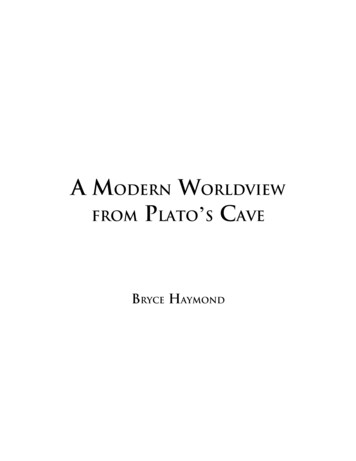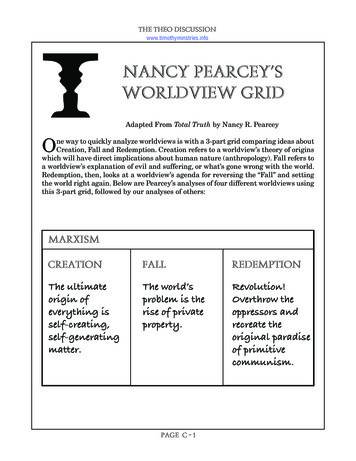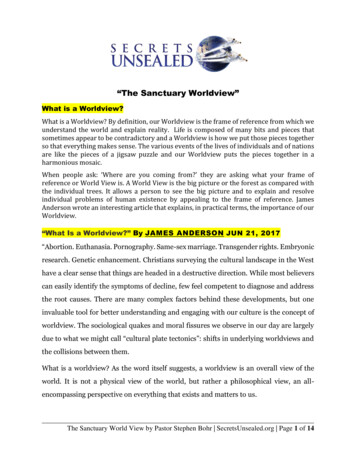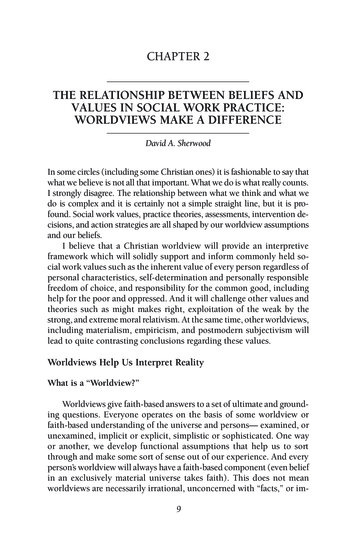
Transcription
A MODERN WORLDVIEWFROM PLATO’S CAVEBRYCE HAYMOND
A Modern Worldview from Plato's Caveby Bryce HaymondMFG 201History of Creativity: Pre-1500Professor Brent StrongBrigham Young UniversityNovember 28, 2005Copyright 2005, 2009 by Bryce HaymondAll Rights Reserved. No part of this publication may be used or reproduced in any formor by any electronic, photographic, or mechanical means, including information storageand retrieval systems, without permission in writing from the author, except in the case ofbrief quotations embodied in critical articles and reviews.Published in the United States by Bryce Haymond, TempleStudy.com.
ContentsIntroduction.1Plato .3The Republic.4Allegory of the Cave.4Origin of Plato’s Cave.7Symbolism of the Allegory.8Allegory of the Cave throughout History.10Socrates.10Aristotle.11Chuang Tzu.11Buddhism.12St. Augustine.12Origen.12Tertullian.13People Who Have Escaped the Cave.13Contemporary Pop 5Literature.16Movies.17The Truman Show.17The Matrix.18Modern Science & Philosophy.22The Holographic Paradigm.22The Fermi Paradox.26The Planetarium Hypothesis.26The Simulation Argument.27Descartes.28Subjective Idealism (Phenomenalism).30LDS Theology.31Why do we see Plato’s cave everywhere?.31In the world but not of the world.34Conclusion.40Appendix A.42Notes.48
Humankind was created with an innate curiosity about the world it inhabits.The earliest unearthed habitations of Mesopotamia show that the peoplethere were earnestly seeking more knowledge about the earth and how togrow the best food. As we study these dwellings, we see how their knowledge about theworld increased as they began to develop agriculture and found ways to flush the land ofsalt buildup. The early Hittites explored the ore they dug from the earth and found theycould smelt it to form iron. The Phoenicians found dyes that could be extracted fromnatural resources of the earth.Sometimes the discoveries and developments in civilizations were more mentalthan physical. The Egyptians looked to religion, particularly the study of the afterlife, toteach them about their existence here in this world and in the next. Other religions, suchas Hinduism, Jainism, Buddhism and Taoism, were created from this same desire toexplain our presence in this world.1
Inventions, such as writing systems, helped people learn more about the worldaround them. These inventions made it possible for knowledge to be passed on from oneperson to another. Instead of each person starting from nothing, they could now build onthe achievements and knowledge of prior thinkers.Of these inventions, the Greek alphabet had an especially profound impact oncivilization and learning. This alphabet was different than any other because it allowedfull phonetic detail to be written down. Instead of just recording ideas, people could nowrecord sounds also. This innovation introduced the capacity to pass ideas on from onegroup to another. Furthermore, the Greeks could write things as they thought them,without being restricted by the established symbols or characters of other languages.Ideas, theories, and stories about this world and the people living in it flourished as theywere able to be clearly written down.One of the first people to take advantage of this new writing system to expressnew philosophies and theories about the known world was Thales. He reasoned, possiblyfor the first time, that the gods did not play chess with the world. He said, “All events,even extraordinary ones, can be explained in natural terms that can be understood byhumans.” 1 This was radical for the age; it meant that man had the ability to trulyunderstand the world around him. Corollary to this was the view that “Underlying all thechange in the world, there is a fundamental order and unity that does not change.” 2Pythagoras, another Greek thinker, further developed this notion and taught that theworld could be explained in terms of math and geometry. This thinking continues toimpact our view of the world.Another Greek intellectual and philosopher that had a profound impact on thethinking of the time emerged two hundred years later during Greek’s Golden Age. Hisname was Plato. Student of Socrates, and later teacher to Aristotle, this man created a2
new theory about the world and the universe that has deeply impacted society throughouthistory.Plato’s concepts, and particularly his depiction of our situation in this world in hisAllegory of the Cave, are reflected today in modern pop culture, including music, TV,literature, and film. Contemporary scientific arguments and philosophical inquiries canalso be viewed in relationship to the allegory. Perhaps most intriguing is the comparisonof the theology of Christianity, particularly the doctrine of The Church of Jesus Christ ofLatter-day Saints, with Plato’s theories. The present western worldview and Plato’sworldview, though separated by nearly two millennia, have many compelling similarities.This may help explain why humanity remains fascinated with the concept of “leaving thecave.”PlatoPlato lived during the height of Greek civilization from 427 to 347 BC. One of thechief students of the well-known thinker and philosopher Socrates in Athens, Platoestablished what could be considered one of the world’s first universities and called it theAcademy. This atmosphere of learning provided a place for his concepts, and those hehad learned from Socrates, to be taught in a clear and orderly way. In fact, many of theteachings of Socrates are now known only through Plato’s writings. At the Academy,Plato began to expound his thoughts about the true nature of reality and this world.Plato taught that there existed a fundamental essence of the universe, a basicconcept he took from Thales. In his own teachings, Plato labeled this essence the Form.He theorized that the Form was the perfect, unchanging, eternal constant of the universethat remained veiled in our current world. The true Form of things was located beyondour existence in the World of Forms. Every item in this world was created to mimic the3
true Form of that particular item as found in the World of Forms; however, in the processof forming that item here on earth, imperfect matter was used and this resulted in a faultyrepresentation of the true Form.An example might clarify this concept. Consider a table. Tables come in manyshapes, sizes, colors, and structures, but we all recognize each variation as a table. Platowould say that any representation of a table has “tableness.” That is, each representationcontains the qualities of the true Form of the table that make us recognize it as a table.However, it remains an imperfect representation of the perfect Form. As Dr. BrentStrong and Mark Davis have said, “To Plato, the physical, material world we can see andtouch was an illusion—it wasn’t real. It was just a corrupted version of the immaterialspiritual world, where all things existed in their perfect Form.” 3 The Form was theperfect, unchanging, eternal essence while the physical representation of it in this worldwas imperfect and changeable. Strong continues, “Therefore, to Plato and his followers,the theoretical or mental was more real than the physical. . . Clearly, for Plato, the worldis not fundamental. The world is an approximation of true reality.” 4 Since our senses areconnected to our physical bodies, they too were considered imperfect, and therefore Platotaught that only the mind could best comprehend the true reality of the Forms.The RepublicOne of the most well-known works of Plato is his book The Republic. In thisbook, Plato describes his vision of the ideal society. He writes that the majority ofhumanity is unable to comprehend the true nature of the Form and, therefore, cannotknow the truth about many things. Accordingly, only those capable of comprehending theForm, usually philosophers, are qualified to be rulers and leaders. A key part of this book4
is an allegory that Plato gives to further explain his view of the nature of the world. It hasbecome known as the Allegory of the Cave.Allegory of the CaveThe context of the Allegory of the Cave is a conversation that Plato is having withone of his students, Glaucon. Plato uses the allegory to clarify his theories of the Formand the state of the world and instructs the student to “take the following parable ofeducation and ignorance as a picture of the condition of our nature.” 5 (Because this textis crucial to our current discussion, it is included in full in Appendix A.6) Here is anillustration of the Allegory of the Cave:Found at ve.jpgWith his Allegory of the Cave, Plato presents a scene of prisoners in a cave.These prisoners are in chains at the back of the cave facing the back wall. They have been5
there all their life and their chains keep their heads immobile so they are unable to lookaround. Behind the prisoners and before the opening to the cave is a fire. In front of thefire are puppeteers that hold objects up over a screen so that their shadows from the fireare cast on the back wall of the cave. These shadows are all that the prisoners have beenable to see their whole lives; therefore, the prisoners take the shadows to be the actualitems. As Plato says, “such persons would certainly believe that there were no realitiesexcept those shadows of handmade things.” 7Plato then poses the question: What would happen if one of the prisoners wasreleased from his chains and allowed to turn his head? In answer, Plato explains that theprisoner would see the objects creating the shadows and realize that what he had seenbefore was a shadow. Plato says, “What do you think he would say, if someone told himthat what he saw before was foolery, but now he saw more rightly, being a bit nearerreality and turned towards what was a little more real? . . . Don’t you think he would bepuzzled, and believe what he saw before was more true than what was shown to himnow?” 8 In other words, it would, initially, be hard for the person to believe that what hesaw before was not the real thing, but just a shadow of the real thing. The person wouldbe puzzled and disoriented.Plato continues the allegory assuming what would happen if the person were thencompelled to go towards the entrance to the cave, towards the real light. The light wouldhurt his eyes, and he would want to turn back to look at the shadows he was used toseeing before. If he were taken to the entrance of the cave and then out into the sunlight,the light would completely blind him and he would not be able to see anything at first. Hewould have to get used to the light. After some time, he would be able to see the things inthe outside world, including the sun.6
What if the person was now reminded of his first place in the cave and of hisfellow prisoners? Plato continues that he would much rather know the truth and be freefrom the cave than be left in that condition – “Would he not feel as Homer says, andheartily desire rather to be serf of some landless man on earth and to endure anything inthe world, rather than to opine as they did and to live in that way?” 9 If he returned to thecave, his eyes would once again go blind and be filled with darkness and he would not beable to see anything for a time. Plato explains that his fellow prisoners would laugh athim, saying that he was not smart to have left the cave. If the freed one were to try andfree the others of their chains, they would try to kill him.Plato concludes his allegory by relating the symbolism given in the story to theworld and its people. We will explore some of this symbolism in a moment. First,however, we will briefly discuss Plato’s possible sources of inspiration for this particularallegory.Origin of Plato’s CaveAs previously noted, the Greek philosophers Thales and Pythagoras precededPlato by about two hundred years. These men established the philosophical foundationupon which Plato built his worldview. Thales first introduced the thought that there was afundamental essence in the universe that did not change. Pythagoras furthered thisthought and theorized that small whole numbers were that fundamental, unchangingelement in the universe. Finally, Plato built upon this and conjectured that the Form wasthe fundamental. It is this view that he developed into the Allegory of the Cave.Nonetheless, the origins of Plato’s cave may not have come solely fromphilosophical sources. John Henry Wright, in his essay “The Origin of Plato’s Cave,” 10theorized that Plato might have visited caves within the general vicinity of Athens that7
gave him the idea for the cave imagery used in the allegory. Wright highlights onepossible cave in particular where slaves working in a mining capacity could have beenobserved by Plato. This scene would have included fires, people, chains, and shadows onthe cave wall just as he relates in the allegory.Symbolism of the AllegoryThe Allegory of the Cave that Plato presents is satiated with symbolism that Platohimself explains in part. He tells us, “The world of our sight is like the habitation inprison, the firelight there to the sunlight here, the ascent and the view of the upper worldis the rising of the soul into the world of the mind.” 11 The cave, therefore, represents theworld, while the prisoners are the people who inhabit the world. The shadows that theprisoners see are everything that people see in the present world, with its objects,environments, events, and so on. As a result, Plato interprets the physical world as onlyan illusion—an imperfect representation of a perfect Form. The chains might representhuman ignorance of the Form. This ignorance inhibits mankind from understanding truth.There has been much discussion over who the puppeteers might represent, asPlato does not give us a suggestion. They seem to understand the ignorant state ofmankind, and be somewhat conniving in their purposes, because they send the images ofthe physical world which are fake or an illusion to the real thing. They thrive on trickeryto keep the prisoners under a leash of ignorance. Who Plato thought the puppeteers werewe may never know, but we can posit that they may be anyone in the world who may bekeeping mankind from knowledge of the true reality.The freed prisoner represents anyone who sees this physical world for the illusionthat it is and who transcends this fallacy with their mind, thereby reaching the World ofthe Forms where one can know truth. Plato referred to these people as the philosophers of8
the world. Once they escape the fake world and know the truth, it is hard to return to theiroriginal habitation, just as it is hard for the prisoner to return to the cave. Plato reasons,that “those who come thither are not willing to have part in the affairs of men, but theirsouls ever strive to remain above.” 12 If they do return to their uninformed company, theyare laughed at and scorned. He continues,Do you think it surprising if one leaving divine contemplations and passing to theevils of men is awkward and appears to be a great fool, while he is still blinking—not yet accustomed to the darkness around him, but compelled to struggle in lawcourts or elsewhere about shadows of justice, or the images which make theshadows, and to quarrel about notions of justice in those who have never seenjustice itself? 13Below is a more artistic rendition of Plato’s cave that was done in the 16th century.It shows philosophers on the left contemplating the fire, while humankind watches theshadows on the wall from behind the screen.Found at http://www2.arnes.si/ kpzkoizo1/platos-cave/jama-osnova-2.jpgThis allegory and its symbolism are fascinating when compared with otherpeoples and cultures throughout history and especially with our present world. Plato’stheories and writings definitely had an impact on Greek society and on many societiesthereafter either because these societies adopted Plato’s ideas, or because Plato’s ideas9
reflected a universal truth later discovered by others. Truth tends to surface in the light ofconcentrated study and inquiry. Plato might have been one of those who attained somefacet of truth. We will now explore these topics.Allegory of the Cave throughout HistorySocratesWe begin by looking at Plato’s tutor, Socrates. Socrates was someone from whomPlato no doubt gleaned knowledge that furthered his own philosophy. Socrates exhibitedmany of the same ideas that Plato later developed into his concepts of the Form and hisAllegory of the Cave. Socrates motto was “Know thyself.” Interestingly enough, thisphrase is included in a line in the movie The Matrix. In the movie, the character Neo isvisiting with the Oracle who is to prophesy if Neo is the One. She asks,“So, what do you think? You think you’re the one?”Neo responds, “I don’t know.”The Oracle points to a decoration on the wall and says, “You know what thatmeans? It's Latin. Means Know thyself'. I'm going to let you in on a little secret. Beingthe One is just like being in love. No one can tell you you’re in love, you just know it.Through and through.”Socrates believed that wisdom was gained through extensive inquiry andexamination of oneself. He did not care as much for the body as he did for the soul. Themind could only get so far in approaching truth while it was connected to the body. 14 Inthis case, his ideas are similar to Plato’s reasoning that this physical world is not asimportant as the mind that can grasp the truth of the Form and transcend this illusoryworld.10
AristotleAristotle was a student of Plato who took his ideas and further developed them tocreate his own philosophy that, in some ways, was at odds with his teacher’s views.Aristotle believed that there were two parts to all things: the matter (or potential) and theForm. He reasoned that the truth of all things could be gained from both the mind and thesoul. His teachings led to the empirical method of scientific reasoning based on thenotion that anything about the known world could be discovered by sensory observations.However, Aristotle also believed that the human mind was somewhat blinded inthis world. In the first book of Metaphysics, he related the human mind to the eyes of abat, which can only see objects in their most obvious shape, and only in a kind of halflight.15 However, if the mind went through the process of reasoning and empiricalobservation, there remained the potential for it to ultimately understand truth.Chuang TzuShifting our gaze to another area of the world, we find Chuang Tzu, a very wellknown Taoist philosopher who lived during the Zhou dynasty of China. One of hissayings was, “While they dream they do not know that they are dreaming. . . By and bycomes the great awakening, and then we shall know that it has all been a great dream. Yetall the while the fools think they are awake, this they are sure of.” 16 Many timesthroughout history people have referred to the human condition as a dream. While wethink we are awake, experiencing reality, we are actually dreaming and everythingaround us is simply an illusion of our mind. Is there any way to know for certain whetherwe are dreaming or whether we are awake? The allusions to Plato’s cave arerecognizable.11
BuddhismLooking at yet another world philosophy, a proverb from Buddhism reads, “Likeimages seen in a dream, thus should one see all things.” 17 Again, we see the reference todreaming. The things we see in this life are “like images seen in a dream,” just illusionsor representations, not true reality.St. AugustineIn the Christian world of the fourth century AD, St. Augustine adopted many ofPlato’s ideas and related them to Christianity. He related the mental and theoreticalimages of Plato to the spiritual. As William G. Smith puts it, “For Augustine, what [was]outside the cave [was] the realm of the Christian God.” 18OrigenAlso working within a Christian framework, Origen, now considered one of thegreat church fathers, was not shy to base his teachings on Greek philosophy, includingthe Plato’s theories. The father of church history in the fourth century, Eusebius, said ofOrigen, “in his metaphysical and theological ideas he played the Greek, giving a Greektwist to foreign tales. He associated himself at all times with Plato, and was at homeamong the writings of . . . followers of Pythagoras.” 19 It is clear, then, that some of thewritings of Origen exhibit Platonic ideas and possible allusions to Plato’s cave. A wellknown Latter-day Saint scholar, Hugh Nibley, observed, “Origen compares the humanintellect at its brilliant best with a tiny little candle, a feeble spark that can hardly light afoot of the way ahead.” 20 We can see that Origen did not think highly of the humanmind. This is similar to Aristotle’s comparison of the mind with the eyes of a bat. Thehuman mind of itself, he argues, does not know much of the truth of the world.12
TertullianHugh Nibley also referenced Tertullian who likened the intellectuals andphilosophers to men stumbling around and groping in the dark. Nibley writes, “Once in awhile. . . [the philosophers] do ‘stumble on the truth by a happy accident,’ but it isinexcusable for a Christian to follow such blind and unreliable guides, since he hassomething far better—a revelation from heaven.” 21 To Tertullian, even the philosopherswere not good guides out of the cave of deception and illusion and into the light of truereality. Only revelation from heaven could serve as that guide. We will explore thesereligious themes found in Plato’s cave later.People Who Have Escaped the CaveAs we have seen, people throughout history have likened their situations to thesame concepts illustrated in Plato’s allegory – that mankind is ignorant of their situationand that there is a higher form of truth and reality out there. Some have speculated thatthere are many that have been able to “escape from the cave” into enlightenment. Theseindividuals could include Socrates, Jesus Christ and his apostles, Gandhi, Joseph Smith,and Martin Luther King Jr. Interestingly enough, when these individuals have tried to“reenter the cave” and bring others to the light, they have been laughed at, rejected, andkilled, just like Plato explains in his Allegory of the Cave. The prisoners did not want toleave the comfortable accommodations of the cave.Contemporary Pop CultureWe have seen how Plato’s allegory surfaces in myriad philosophies of the past;however, we may ask if it is still present today. We will examine several different aspectsof modern pop culture that exhibit Plato’s themes. Then we will explore these same ideas13
in modern science and philosophy, after which we will look at these concepts as theyrelate to Christianity, and more specifically, LDS theology and doctrine.Anarchists/CounterculturePlato’s Allegory of the Cave contains a subject matter which sounds very muchlike an anarchist, counterculture, or revolutionary view of the world. A revolutionarymight say that we are all under the heavy hand of control, tyranny, and government andthat we are bound to break free from these bonds and achieve liberty. Che Guevara, aCuban revolutionary, could be compared to the freed prisoner that enters the cave torelease the other prisoners and set them free. In 1965 Che left Cuba in attempt to raisesocialist revolutions amongst citizens of countries worldwide.MusicAdditionally, there have been several musical groups or songs in this century thathave had a relationship to Plato’s cave. Rage Against the Machine was a political musicalgroup that promoted revolutionary ideas. They Might Be Giant’s song “No One KnowsMy Plan,” Jack Johnson’s “Inaudible Melodies,” and Pere Ubu’s “Heart of Darkness” allrefer to the allegory in their lyrics. Rush’s album 2112 can be seen as a type of sci-fiAllegory of the Cave. These musical groups no doubt related to the philosophy of Platoand his cave, and chose to incorporate it into their songs.TVTelevision shows have also experimented with Plato’s philosophy of illusions orof a simulated environment which is not true reality. One TV show that comesimmediately to mind is the Star Trek series and its holodeck. On the holodeck, a specialroom on the starship Enterprise, crew members may recreate any reality they choose by14
just sending certain commands to the ship’s computer. These realities seem authentic andthe crew members can interact with, touch, taste, smell, and be a very real part of asimulated environment. A typical interaction on the holodeck might begin like this:“Computer, give me Earth, year – 1066 AD, location – Battle of Hastings.”The computer would look up the details of this time period (environment, people,customs, etc.) in its databanks and then recreate it in a 3D environment on the holodeck.The crew member could then interact with the people and the environment of that time asif they were actually there. Of course it is just a simulation and a crew member cannot dieon the holodeck because of the safety guards that are in place.When the crew member was done they would say, “Computer – end program.”The simulated environment would then close and the person would be left in the emptyroom of the holodeck.Relating the holodeck with Plato’s cave, the computer would be a type ofpuppeteer, manipulating the simulated images and environments on the holodeck. Thecrew member would be the prisoner viewing the images. Nothing the crew member wasdoing on the holodeck would be true reality, but fake and illusory. The differencebetween the holodeck and Plato’s cave is that crew members purposefully entered asimulated environment to learn something new or to experience something that theycould not otherwise experience on the starship. In this ironic way, they were trying tolearn or experience something new and real in a fake and simulated environment.LiteratureThe Allegory of the Cave can also be seen in today’s literature. Science fictionnovels based in a counterfeit reality are plentiful as is the idea of an artificial intelligenceconquering the human race. Some that are of note were written by William Gibson,15
particularly his
Latter-day Saints, with Plato's theories. The present western worldview and Plato's worldview, though separated by nearly two millennia, have many compelling similarities. This may help explain why humanity remains fascinated with the concept of "leaving the cave." Plato Plato lived during the height of Greek civilization from 427 to .










